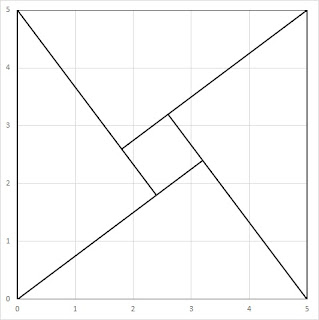Dakota Jones needs a crystal key to gain access to a hidden temple deep in the Riddlerian Jungle. She already knows the crystal is a polyhedron, and according to an ancient text, it has exactly six edges, five of which are 1 inch long. Cryptically, the text does not specify the length of the sixth edge. Instead, it says that the key is the largest such polyhedron (i.e., with six edges, five of which have length 1) by volume.
Once again, Dakota Jones needs your help. What is the volume of the crystal key?
So firstly, Dakota surmises that with only six edges, she must be looking for a polyhedron with $V=4$ vertices, since there would then be $E = \binom{V}{2} = 6$ edges. Furthermore, she can reduce the problem by assuming that at least one face of the polyhedron must be a triangular prism, where at least one face must be an equilateral triangle (since $5$ out of the $6$ edges are unit length).
So without loss of generality, Dakota will assume that the equilateral triangle is situated along the $xy$-plane with vertices as $(0,0,0),$ $(1,0,0)$ and $(1/2, \sqrt{3}/2,0).$ Let $v = (x,y,h)$ be the remaining vertex. Without loss of generality, we would have that the distance from $(0,0,0)$ to $v$ is $1$ and the distance from $(1,0,0)$ to $v$ is 1, that is, $$x^2 + y^2 + h^2 = 1 \,\,\,\text{and}\,\,\, (x-1)^2 + y^2 + h^2 = 1.$$ Furthermore, the volume of such a triangular pyramid would be $$V(h) = \frac{1}{3} B h = \frac{\sqrt{3}}{12} h.$$
By symmetry, for any $y$ and $h,$ if $(x,y,h)$ solves both equations then we must have $(x-1)^2 = x^2,$ or $x = \frac{1}{2}.$ Therefore, we must have $v = (1/2,y,h)$ and we can solve for $h$ in terms of the variable $y$ (without loss of generality choosing the positive solution) to get $$h(y) = \frac{\sqrt{3-4y^2}}{2},$$ so for any $|y| \leq \sqrt{3}/2$ the vertex $v_y = (1/2, y, \frac{\sqrt{3-4y^2}}{2})$ is the remaining vertex of a possible $6$-edged polyhedron with $5$ sides of length $1.$ Since we are looking for the polyhedron with largest volume, we have see that $$\tilde{V}(y) = V(h(y)) = \frac{\sqrt{3 (3 - 4y^2)}}{24},$$ which has maximal value when $y = 0.$ In this case, the optimal vertex is located at $(1/2, 0, \sqrt{3}/2)$ and the volume of the cyrstal key is $$V_\max = \tilde{V}(0) = \frac{1}{8}.$$



